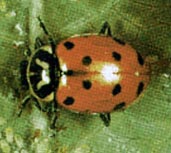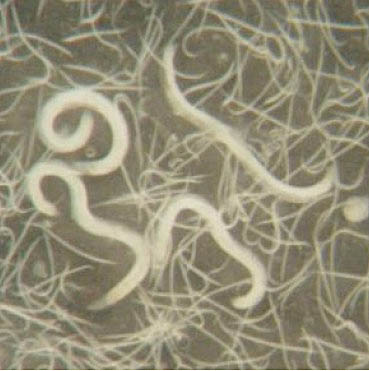Biological Control: Putting Beneficial Insects to Work
By Pat Dickey, Fairfax Master Gardener
There are many ways to eliminate pests in our flower beds and vegetable patches, but biological control is a method organic gardeners advocate. Simply put, biological control suppresses or prevents a pest outbreak by manipulating the pest’s natural enemies. Biological control does not completely get rid of the problem. Natural enemies require their prey or hosts for survival, so a small population of the pest is always needed. Biological control does, however, keep the nuisance at tolerable levels–without the negative effects of chemical pesticides on our health and environment.

Hippodamia convergens. Common American lady beetle often sold to gardeners for insect control
The three Ps of biological control
Natural enemies of pests are also known as beneficials. There are three types of beneficials in insect pest control: predators, parasitoids, and pathogens.
Predators
Beneficial insects that actively consume many other insect pests during their lives are predators. Some predators feed only on one or a few species of insects, but most are generalists and feed on a variety of insect prey, and even each other. The most common insect predators are lady beetles, ground and soldier beetles, praying mantids, assassin bugs, predatory stink bugs, and the larvae of lacewings and flower flies.

Braconid wasp laying eggs in an aphid.
These are natural enemies that lay eggs in or on a host insect pest. Most parasitoids are host-specific. Examples of parasitoids are tachinid flies, trichogramma wasps, braconid wasps, ichneumonid wasps, scale parasites, and whitefly parasites. Most are so tiny that they are rarely noticed. Parasitoids can be spotted through changes occurring in their hosts.
| Pathogens These are microscopic organisms, such as bacteria, fungi and nematodes. They work in different ways; some cause disease in the target pest population; others release chemicals that are toxic to the target population. Some nematodes work as tiny parasites. When inside the insect, they release bacteria that infect and kill the target pest. How to use biological controls1. Assist beneficial insects already in your landscape. |
 These nematodes are used to control Japanese beetle grubs and other insects. |
- Plants with different flowering times around the garden and within the garden rows offer food and refuge habitats.
- Use of straw mulch during the growing season provides humid, sheltered hiding places for ground-dwelling predators.
- Areas left untilled or made into natural vegetation or perennial plant beds give areas for natural enemies to overwinter.
- All pesticides should be avoided when plants are in bloom and beneficial insects are present.
2. Add beneficial insects to your landscape.
The gardener can purchase and release natural enemies that are already present in the United States to control pests. Some of these can be purchased at local garden centers; others are available online.
The correct identification of pests in need of control is extremely important, and the predator or parasite should be present when the pest first emerges or appears.
A smaller release is used where the beneficial cannot overwinter and must be introduced each spring to control the pest. Larger releases are meant to overwhelm a damaging pest population. In neither case does this approach permanently suppress the target pests.
| Predators and parasitoids commonly available to the home gardener | ||
| Predator or Parasitoid | Target Pest | Notes |
| Bean beetle parasitic wasps | Mexican bean beetle larvae | Sold with the parasitic wasps already inside their hosts. Females emerge and lay eggs in other bean beetle larvae in the garden |
| Lady beetles | Aphids and other soft-bodied insects and mites | Predator. Best released at night when they do not fly. |
| Lacewings | Aphids and other soft-bodied insects and mites | Predator |
| Trichogramma wasps | Caterpillars that attack the crucifer crops such as kale, cabbage and broccoli | Parasitoid |
| Predatory mites | European red mite, Two-spotted spider mites | Predator |
| Pathogens commonly available to the home gardener | ||
| Pathogen | Target Pest | Notes |
| Bacterial strains of Bacillus thuringiensis (Bt) | Selective control of caterpillars, mosquito larvae, and Colorado potato beetle larvae | The insect’s gut is paralyzed after Bt is consumed. Bt comes in powder form to be sprayed or dusted on the infected plants |
| Beauveria bassiana | Infects aphids, whiteflies, and certain beetles on contact through the cuticle. | Fungal spray. The fungus covers the dead insect with a downy mold that releases infective spores into the environment |
| Milky spore (Bacillus popilliae) | Japanese beetle grubs | May take several years to have a significant effect. Some recent evidence suggests that Milky spore is losing effectiveness |
| Predatory nematodes | Ground dwelling pests such as white grubs and boring insects | Mixed with water and usually applied to moist soil late evening or early morning |
3. Start small.
To gain confidence and experience, begin by using new biological control methods on a small scale. Try new practices on a small field or plot so that mistakes will not be costly. Spend time identifying natural enemies by watching their activities and assessing their impact on pests. Soon you will be ready to try what you have learned on a larger scale. If you have any questions, contact Virginia Cooperative Extension Help Desk at 703-324-8556.
References
• Biological Control: A Guide to Natural Enemies in North America, Cornell University, College of
Agriculture and Life Sciences
• Biological Control of Insects and Mites, Cooperative Extension, University of Wisconsin-Extension (2008)
• Biological Pest Controls in the Home Landscape, Oklahoma Cooperative Extension Service (2015)
HLA-6434
• Pest Management Guide, Virginia Cooperative Extension Service: Ch. 2 Home Vegetables
• Natural Enemies, Home and Garden Information Center, University of Maryland
• Commercial Sources of Predators, Parasitoids, and Pathogens, University of Tennessee Agricultural
Extension Service, SP290-Z